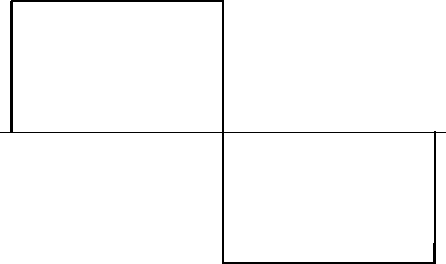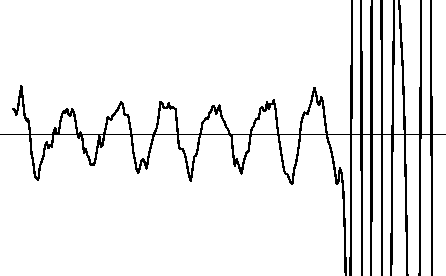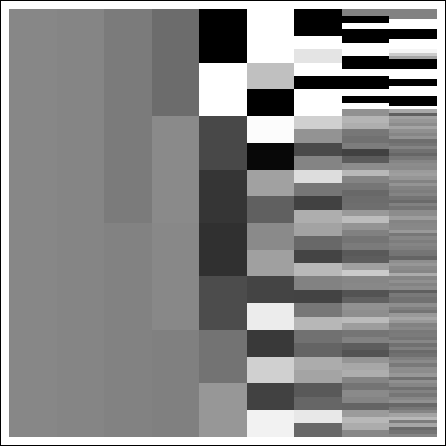![[*]](http://sepwww.stanford.edu/latex2html/cross_ref_motif.gif) with various shifts and stretches, much like the Fourier transform
cross-multiplies a function against a sine wave with two phases and many
stretches.
with various shifts and stretches, much like the Fourier transform
cross-multiplies a function against a sine wave with two phases and many
stretches.
The Haar transform is the simplest of the wavelet transforms.
This transform
cross-multiplies a function against the wavelet shown in Figure ![[*]](http://sepwww.stanford.edu/latex2html/cross_ref_motif.gif) with various shifts and stretches, much like the Fourier transform
cross-multiplies a function against a sine wave with two phases and many
stretches.
with various shifts and stretches, much like the Fourier transform
cross-multiplies a function against a sine wave with two phases and many
stretches.
|
haarplot
Figure 7 The Haar wavelet. |  |
As an example of a Haar transform, consider transforming
the single seismic trace
shown in Figure ![[*]](http://sepwww.stanford.edu/latex2html/cross_ref_motif.gif) .
The Haar transform of this trace is shown in Figure
.
The Haar transform of this trace is shown in Figure ![[*]](http://sepwww.stanford.edu/latex2html/cross_ref_motif.gif) .
Notice that the trace consists of two zones, a weak zone
on the left side,
and a strong zone on the right side. We see this
pattern of strong and weak zones reflected as octave zones within
the transform shown in
Figure
.
Notice that the trace consists of two zones, a weak zone
on the left side,
and a strong zone on the right side. We see this
pattern of strong and weak zones reflected as octave zones within
the transform shown in
Figure ![[*]](http://sepwww.stanford.edu/latex2html/cross_ref_motif.gif) .
.
The samples in the Haar transform shown in Figure ![[*]](http://sepwww.stanford.edu/latex2html/cross_ref_motif.gif) are coefficients that describe the decomposition of the trace in
Figure
are coefficients that describe the decomposition of the trace in
Figure ![[*]](http://sepwww.stanford.edu/latex2html/cross_ref_motif.gif) . A simple example of the Haar decomposition is
taken from Strang(1989). If f is a 4-sample trace, then
. A simple example of the Haar decomposition is
taken from Strang(1989). If f is a 4-sample trace, then
 |
(1) |
The first sample in Figure ![[*]](http://sepwww.stanford.edu/latex2html/cross_ref_motif.gif) contains the
coefficient that describes the D.C. component of the trace.
The next sample
contains the coefficient that describes how a single Haar wavelet
shown in Figure
contains the
coefficient that describes the D.C. component of the trace.
The next sample
contains the coefficient that describes how a single Haar wavelet
shown in Figure ![[*]](http://sepwww.stanford.edu/latex2html/cross_ref_motif.gif) cross-multiplies the entire trace.
Then, the next two samples describe the two Haar wavelets that cross-multiply
two-halves of
the trace; one
cross-multiplying the first half of the trace, the other cross-multiplying
the last half of the
trace.
This halving of the wavelet and of the trace continues until
the Haar wavelets are two samples long, and the number of coefficients
required to describe the cross-multiplication are half the trace length.
On the right side of Figure
cross-multiplies the entire trace.
Then, the next two samples describe the two Haar wavelets that cross-multiply
two-halves of
the trace; one
cross-multiplying the first half of the trace, the other cross-multiplying
the last half of the
trace.
This halving of the wavelet and of the trace continues until
the Haar wavelets are two samples long, and the number of coefficients
required to describe the cross-multiplication are half the trace length.
On the right side of Figure ![[*]](http://sepwww.stanford.edu/latex2html/cross_ref_motif.gif) , in the last half
of the trace, the amplitude pattern of the original trace is clearly
reflected.
This pattern may also be seen within the other octave zones.
, in the last half
of the trace, the amplitude pattern of the original trace is clearly
reflected.
This pattern may also be seen within the other octave zones.
|
trace
Figure 8 A seismic trace with a low-energy zone and a high-energy zone. |  |
|
haartrace
Figure 9 The Haar transform of the seismic trace shown in the previous figure. |  |
An alternate and perhaps more understandable method of displaying the
results of a wavelet transform is in the two-dimensional display shown in
Figure ![[*]](http://sepwww.stanford.edu/latex2html/cross_ref_motif.gif) . The vertical axis
is the time axis corresponding to the time axis of the trace. The horizontal
axis corresponds to the sizes of the Haar wavelets.
Where the longer operators have barely visible coefficients in Figure
. The vertical axis
is the time axis corresponding to the time axis of the trace. The horizontal
axis corresponds to the sizes of the Haar wavelets.
Where the longer operators have barely visible coefficients in Figure
![[*]](http://sepwww.stanford.edu/latex2html/cross_ref_motif.gif) , Figure
, Figure ![[*]](http://sepwww.stanford.edu/latex2html/cross_ref_motif.gif) gives more emphasis to the
long-operator coefficients and maintains the relative time scales within
each set of coefficients.
gives more emphasis to the
long-operator coefficients and maintains the relative time scales within
each set of coefficients.
|
dhaartrace
Figure 10 The alternate display form of the Haar transform. The horizontal axis corresponds to the Haar wavelets sizes, and the vertical axis corresponds to the time axis of the trace. Notice that time increases vertically, opposite to the standard seismic display convention. This figure shows the same information as Figure 9. |  |
The algorithm is simple, however there is not an obvious use for the transformed data. The data is localized in time, but the frequency separation is poor when compared to the sliding Fourier transform.